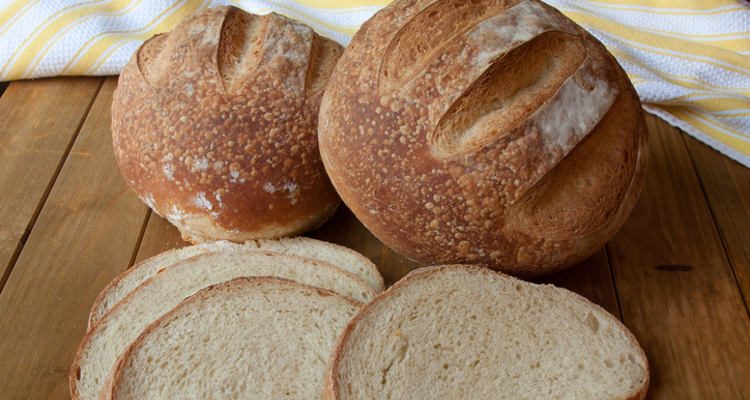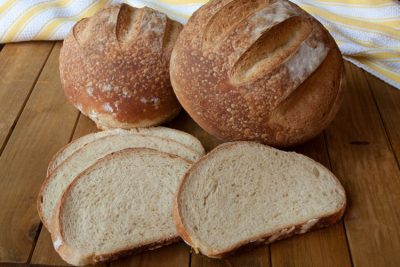
Bread gets a bad rap in general, and for good reason. Bread can lead to weight gain, high blood sugar, and digestive issues. That being said, many bread lovers are curious about healthier choices.
Is sourdough bread healthy instead? One slice of sourdough bread will contain about 96 calories. There is also a significant amount of sourdough bread nutrition to consider.
However, there is another reason sourdough bread should be eaten instead of other types of bread. You see, most bread you find in grocery stores contains phytic acid, which inhibits enzymes that are needed for starch and protein breakdown in the stomach.
A lack of enzymes will result in digestive problems. Anyone with wheat intolerance will surely get the picture.
But, the wild yeast and lactobacillus bacteria in the leaven of flour in sourdough bread will actually neutralize the phytic acid through acidification of the dough.
This will prevent the effects of phytic acid, which makes the bread easier to digest. The long and slow fermentation of wheat is known to decrease phytates by up to 90%.
Also, in most bread, phytic acid will bind with minerals like zinc, iron, and magnesium, which prevent them from being retained in the body. However, sourdough bread bacteria will pre-digest the flour to release key micronutrients.
Sourdough Bread Nutrition
| Nutrient | Amount | Daily Value |
|---|---|---|
| Calories | 92.5 | 5.00% |
| Carbohydrates | 18.1g | 6.00% |
| Fiber | 0.8g | 3.00% |
| Protein | 3.8g | 8.00% |
| Total Fat | 0.6g | 1.00% |
| Iron | 1.2mg | 6.00% |
| Manganese | 0.2mg | 8.00% |
| Calcium | 14.1mg | 1.00% |
| Copper | 0.04mg | 2.00% |
| Magnesium | 9.0mg | 2.00% |
| Phosphorus | 36.5mg | 4.00% |
| Potassium | 41.0mg | 1.00% |
| Zinc | 0.3mg | 2.00% |
| Selenium | 8.7mcg | 12.00% |
| Vitamin B1 | 0.1mg | 9.00% |
| Vitamin B2 | 0.1mg | 5.00% |
| Vitamin B3 | 1.5mg | 8.00% |
| Folate | 47.4mcg | 12.00% |
| Vitamin B5 | 0.1mg | 1.00% |
| Choline | 4.7mg | N/A |
| Betaine | 17.6mg | N/A |
* N/A—Not Applicable
What is the healthiest bread to eat? Sourdough bread is just four ingredients, including salt, water, flour, and the sourdough starter. It is also free from food additives that are often blamed for wheat or gluten intolerance in some people.
However, sourdough may be the healthiest type of bread due to its deep concentration of micronutrients, and its superior taste and texture.
Each slice of sourdough bread contains a good amount of
- Folate,
- Vitamin B2,
- Vitamin B3,
- Vitamin B3,
- Selenium,
- Manganese,
- Iron.
- vitamin C,
- vitamin E,
- vitamin K,
- vitamin B6,
- vitamin B5,
- choline,
- betaine,
- calcium,
- magnesium,
- phosphorus,
- zinc,
- copper.
- carbs,
- fiber,
- protein.
Sourdough Bread’s Health Benefits: What Makes it the Healthiest Bread?
Is sourdough bread healthy? Well, there are quite a few health benefits of sourdough bread. For starters, it is made from sourdough starter instead of baker’s yeast found more modern breads.
Sourdough starter was used to make bread before commercial baker’s yeast was introduced. There are actually many benefits of sourdough bread that is naturally fermented. The following are five benefits of sourdough bread you should consider before you avoid bread altogether from your diet.
1. It is a Natural Probiotic
Natural probiotic foods are those that have been fermented and contain good bacteria like Lactobacillus acidophilus, Lactobacillus bulgarius, and Bifidobacterium bifidum. Some popular probiotic foods include sauerbraut, kimchi, kefir, yogurt, and tempeh.
Also, add sourdough bread to that list, as sourdough contains Lactobacillus. Probiotic foods improve digestion, boost the immune system, and lead to healing from leaky gut and inflammatory bowel disease.
Sourdough will inhibit the growth of bad bacteria by creating a more acidic environment through the production of antibacterial agents, and the absorption of B vitamins.
2. Help Properly Absorb Nutrients:
The beneficial bacteria Lactobacillus in sourdough bread is responsible for improving the balance of good and bad bacteria in the gut.
As a result, it helps the body absorb the nutrients it needs for overall health. Also, to absorb calcium, magnesium is required. For magnesium absorption, vitamins like vitamin C and vitamin E are necessary.
Sourdough bread contains these nutrients and more, which makes it a food that gives optimal absorption to your body.
3. Good for Diabetics:
Studies have found that sourdough bread can help regulate blood sugar levels, which can be good for the prevention and treatment of diabetes.
In a 2008 study published in the journal Acta Diabetologica, researchers found that sourdough bread may benefit people with impaired glucose metabolism.
Sourdough lactic acid bacteria produces acetic, lactic, and propionic acids that cause interactions that reduce starch availability under the heat of baking. This process reduces postprandial glycemic responses.
4. Beneficial for Those with Gluten Intolerance:
Acids do not allow for the growth of mold and most bad bacteria. Sourdough bread contains acids that will break down and remove some of the gluten from the sourdough bread.
Also, the sourdough microflora also has all the available amino acids without the protein that forms gluten.
Sourdough will also dissolve four gluten-forming proteins, including albumin, prolamin, glutalin, and globulin. These proteins produce alcohol that will dissolve most water insoluble protein bonds, which are a major reason why many people suffer from gluten intolerance.
5. May Treat Autoimmune Diseases:
The lactic acid bacteria naturally found in sourdough bread produces beneficial compounds like antioxidants, anti-allergenic substances, and the cancer-preventive peptide lunasin, which may help treat autoimmune diseases.
How to Make Sourdough Bread
It is always best to know what is in your food. That is why making sourdough bread is always better than buying it. Some people think sourdough bread is difficult to make, but it is really just about understanding how the dough behaves, and the different factors that affect it. The following is an easy sourdough bread recipe that you will likely enjoy making.
Ingredients:
- 2 1/3 cups of fresh sourdough starter
- 3 1/3 cups of flour (or try a gluten-free flour like almond or brown rice flour)
- 1 to 1 1/2 cups of water
- 1 tbsp. of Celtic grey sea salt
Directions:
- Mix together flour, salt, and sourdough starter, and add a cup of water, then more water as needed to make moist bread dough.
- Knead the dough until a small piece of dough will stretch between four fingers thin enough to allow light to pass through without breaking.
- Split the dough in half, and shape each half into a loaf.
- Place in a loaf pan, and cover lightly with a towel and proof for 24 hours.
- Slice an x shape on top of the loaf with a very sharp knife or razor blade to allow the loaf to expand during baking without splitting it in unexpected areas.
- Bake at 400 degrees Fahrenheit for 30 to 60 minutes, depending on the loaf size, or until it reaches an internal temperature of 190 to 210 degrees Fahrenheit. Cool for about 20 to 30 minutes before slicing.
Conclusion
It is also important to note that the acetic acid in sourdough bread inhibits the growth of mold. This means that sourdough bread naturally preserves itself, and no toxic preservatives are necessary.
Although there are plenty of benefits, is sourdough bread bad for you? There is still gluten in the flour unless you use gluten-free flour like brown rice or almond. This is why people with celiac disease should still avoid sourdough bread.
That being said, most people with gluten sensitivity may be able to enjoy sourdough bread. For those that have avoided gluten for a long time, give sourdough bread a try, and see how you feel. You may be surprised that you can handle this bread.
Sources:
Kimbell, V., “Why Is It That I Can Digest Sourdough Bread and Not Commercial Bread?” The Sourdough School website; http://www.sourdough.co.uk/why-is-it-that-i-can-digest-sourdough-bread-and-not-commercial-bread/, last accessed Jan. 23, 2017.
“Sourdough 101: Crash Course,” Don’t Waste the Crumbs website, June 7, 2013; http://dontwastethecrumbs.com/2013/06/what-is-sourdough-benefits-of-sourdough-bread/.
“Bread, French or Vienna (includes sourdough) Nutrition Facts & Calories,” SELFNutritionData website; http://nutritiondata.self.com/facts/baked-products/4841/2, last accessed Jan. 24, 2017.














